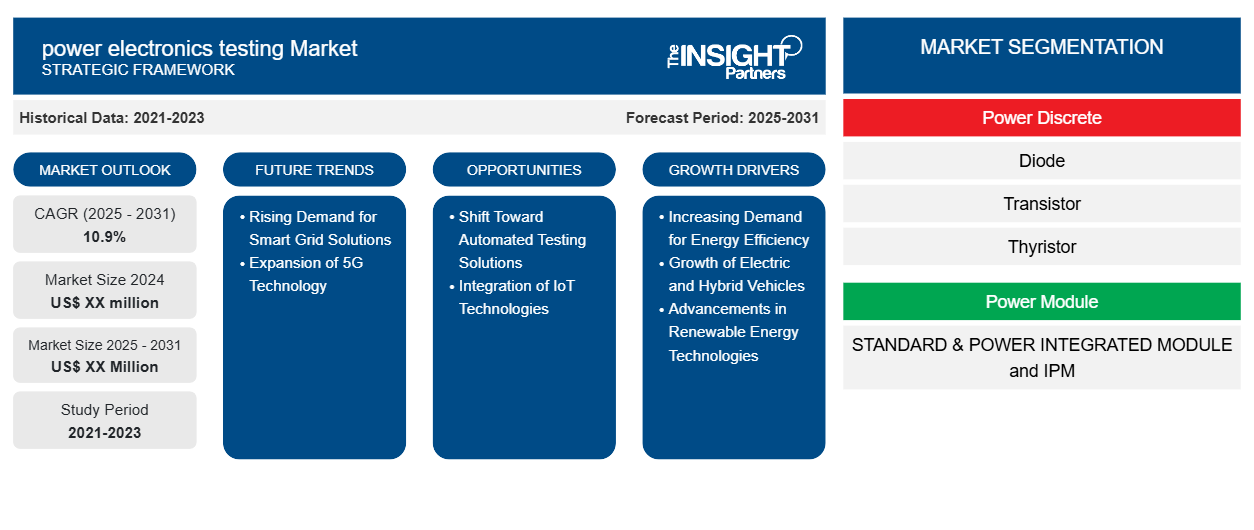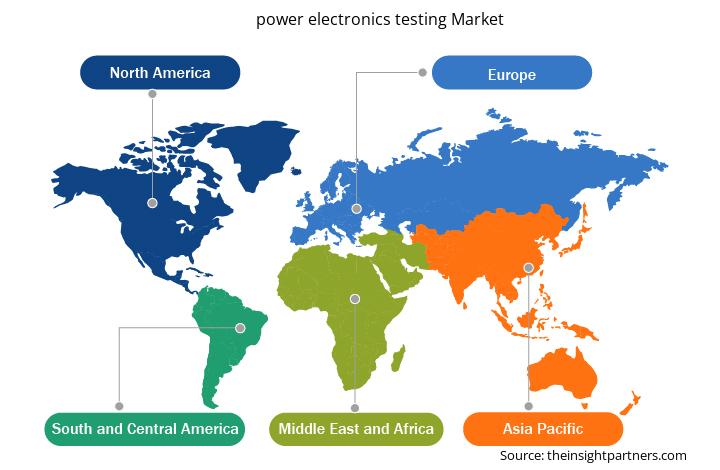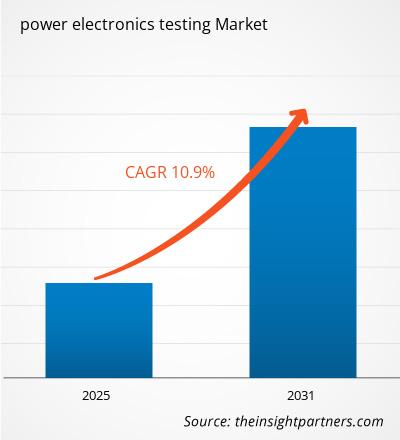预计电力电子测试市场在 2025 年至 2031 年期间的复合年增长率为 10.9%,市场规模将从 2024 年的 XX 百万美元扩大到 2031 年的 XX 百万美元。
本报告按功率分立器件(二极管、晶体管、晶闸管)、功率模块(标准模块、功率集成模块和智能功率模块)进行细分,并进一步按区域和主要国家细分了全球分析。报告以美元为单位,提供上述分析和细分市场的价值。
报告目的
Insight Partners 发布的《电力电子测试市场》报告旨在描述电力电子测试市场的现状和未来增长、主要驱动因素、挑战和机遇。这将为各业务利益相关者提供深刻见解,例如:
- 技术提供商/制造商:了解不断变化的市场动态并了解潜在的增长机会,使他们能够做出明智的战略决策。
- 投资者:对市场增长率、市场财务预测以及整个价值链中存在的机会进行全面的趋势分析。
- 监管机构:规范市场政策和警察活动,旨在最大限度地减少滥用行为,维护投资者的信任和信心,维护市场的完整性和稳定性。
电力电子测试市场细分
功率分立器件
- 二极管
- 晶体管
- 晶闸管
电源模块
- 标准及功率集成模块和IPM
定制此报告以满足您的要求
您可以免费定制任何报告,包括本报告的部分内容、国家级分析、Excel 数据包,以及为初创企业和大学提供优惠和折扣
电力电子测试市场:战略洞察

-
获取此报告的顶级关键市场趋势。此免费样品将包括数据分析,从市场趋势到估计和预测。
电力电子测试市场增长动力
-
能源效率需求不断增长:
全球对能源效率的追求是电力电子测试市场的主要驱动力。随着各行各业和消费者寻求降低能耗和成本,电力电子技术在优化各种应用(包括电动汽车和可再生能源系统)的能源使用方面发挥着至关重要的作用。这一需求需要进行严格的测试,以确保电力电子设备符合能效标准和监管要求。 -
电动和混合动力汽车的增长:
汽车行业向电动和混合动力汽车的转变极大地推动了电力电子测试市场的发展。这些汽车在电池管理、能量转换和推进系统方面严重依赖先进的电力电子技术。随着汽车制造商加大对高性能电动和混合动力车型的投入,对电力电子元件进行全面测试对于确保安全性、可靠性和性能至关重要。 -
可再生能源技术的进步:
太阳能和风能等可再生能源的快速增长是电力电子测试市场的另一个驱动力。电力电子技术对于转换和管理这些能源产生的电能至关重要。为了确保最佳性能和电网整合,对转换器、逆变器和其他电力电子设备进行测试至关重要。这一趋势凸显了强大的测试解决方案对于支持不断扩张的可再生能源行业的重要性。
电力电子测试市场未来趋势
-
智能电网解决方案需求不断增长:
向智能电网技术的转型为电力电子测试市场带来了巨大的机遇。智能电网需要先进的电力电子技术来更好地管理、分配和整合可再生能源。随着公用事业公司和能源供应商纷纷采用智能电网基础设施,能够验证这些系统性能和互操作性的测试解决方案将变得至关重要,从而推动测试市场的增长。 -
5G技术的扩展:
5G技术的推出正在为电力电子测试市场创造新的机遇。5G网络依赖先进的电力电子技术实现高效的信号处理和能源管理。随着电信公司不断扩展其基础设施,对能够确保5G应用中电力电子器件可靠性和效率的测试解决方案的需求将不断增长,这为测试服务提供商提供了一个利润丰厚的市场。
电力电子测试市场机遇
-
向自动化测试解决方案转型:
电力电子测试市场的一个重要趋势是向自动化测试解决方案转型。自动化提高了测试效率、准确性和可重复性,使制造商能够在更短的时间内完成全面的测试。随着电力电子技术日益复杂,能够同时处理多个测试参数的自动化测试系统的需求日益增长,从而简化了测试流程并降低了人工成本。 -
物联网技术集成:
物联网 (IoT) 技术与电力电子测试的集成正成为一种重要趋势。基于物联网的测试解决方案可在测试过程中实现实时监控和数据收集,从而实现预测性维护和性能优化。这一趋势增强了测试能力,为制造商提供有关设备性能和潜在故障的宝贵见解,最终提高产品可靠性和客户满意度。
电力电子测试市场区域洞察
Insight Partners 的分析师已详尽阐述了预测期内影响电力电子测试市场的区域趋势和因素。本节还讨论了北美、欧洲、亚太地区、中东和非洲以及南美和中美洲的电力电子测试市场细分和地域分布。

- 获取电力电子测试市场的区域特定数据
电力电子测试市场报告范围
| 报告属性 | 细节 |
|---|---|
| 2024年的市场规模 | XX百万美元 |
| 2031年的市场规模 | XX百万美元 |
| 全球复合年增长率(2025-2031) | 10.9% |
| 史料 | 2021-2023 |
| 预测期 | 2025-2031 |
| 涵盖的领域 |
由 Power Discrete
|
| 覆盖地区和国家 |
北美
|
| 市场领导者和主要公司简介 |
|
电力电子测试市场参与者密度:了解其对业务动态的影响
电力电子测试市场正在快速增长,这得益于终端用户需求的不断增长,而这些需求的驱动因素包括消费者偏好的不断变化、技术进步以及对产品优势的认知度不断提高。随着需求的增长,企业正在扩展产品线,不断创新以满足消费者需求,并抓住新兴趋势,从而进一步推动市场增长。
市场参与者密度是指特定市场或行业内企业或公司的分布情况。它表明特定市场空间内竞争对手(市场参与者)的数量相对于其规模或总市值而言。
在电力电子测试市场运营的主要公司有:
- 爱德万测试株式会社(日本)
- 泰瑞达公司(美国)
- 罗德与施瓦茨(德国)
- Chroma ATE Inc.(台湾)
- 和 Cohu Inc.(美国)。同时SGS SA(瑞士)
- 法国国际检验局
免责声明:以上列出的公司没有按照任何特定顺序排列。

- 获取电力电子测试市场主要参与者概览
主要卖点
- 全面覆盖:报告全面涵盖了电力电子测试市场的产品、服务、类型和最终用户的分析,提供了整体概况。
- 专家分析:本报告基于对行业专家和分析师的深入了解而编写。
- 最新信息:该报告涵盖了最新信息和数据趋势,确保了业务相关性。
- 定制选项:此报告可以定制以满足特定客户要求并适合业务策略。
因此,电力电子测试市场研究报告有助于引领解读和理解行业现状及增长前景。尽管存在一些合理的担忧,但本报告的总体优势往往大于劣势。
- 历史分析(2 年)、基准年、预测(7 年)及复合年增长率
- PEST和SWOT分析
- 市场规模、价值/数量 - 全球、区域、国家
- 行业和竞争格局
- Excel 数据集
近期报告
相关报告
客户评价
购买理由
- 明智的决策
- 了解市场动态
- 竞争分析
- 客户洞察
- 市场预测
- 风险规避
- 战略规划
- 投资论证
- 识别新兴市场
- 优化营销策略
- 提升运营效率
- 顺应监管趋势






















 获取免费样品 - 电力电子测试市场
获取免费样品 - 电力电子测试市场